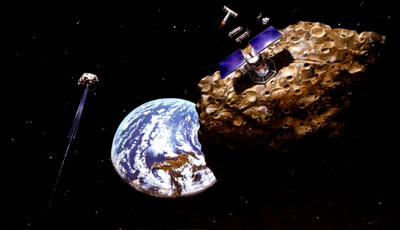asteroid mining

Artist's concept of asteroid mining. Image credit: NASA.
As Earth's supply of minerals and metals begins to run low, thoughts turn to the possibility of mining the almost limitless reserves on other worlds, most obviously the Moon (because it's so close) and asteroids (because of their very low surface gravity, making it easy to launch things from their surface).
Mining asteroids for their mineral wealth has been talked about for many years and written about in countless science fiction stories. But recently, plans have begun to emerge that would make this a practical proposition within a decade or two. Already, spacecraft have passed by, orbited, landed on, and returned samples of asteroids. Now, there is even a private company, called Planetary Resources, which has been set up to up to tap into this potentially lucrative business of shipping industrial quantities of asteroidal material to Earth. And asteroids could provide not only metals, but also the raw ingredient for rocket fuel – water – which could be sent to a depot in space for processing into hydrogen and oxygen, which could then be liquefied and loaded into the tanks of spacecraft,
Asteroids as a resource
About 9,000 near-Earth asteroids have been discovered today and that number is increasing by about 1,000 per year. A good number of these – those that pass reasonably close by the Earth on a regular basis – are as easy to get to as the Moon, and their extremely low surface gravity would make it easy to launch material from them to collection points in Earth orbit or elsewhere in the solar system where they could be utilized.
Asteroids have other advantages. Unlike on Earth, where most heavier metals, such as iron and nickel, tend to have sunk close to or into the core, where they're inaccessible, these metals are distributed throughout the bodies of asteroids, making them easier to extract. These metals, as well as rare platinum group metals, often occur on asteroids in higher concentrations than on Earth. And, water – vital to living in space (in liquid form and as a source of breathable air) and fuel for space transportation, in readily extractable form, is abundant on the surface of almost all asteroids.
Planetary resources
Call it pie in the sky, a flash in the pan, or wishful thinking, but a new company known as Planetary Resources ("The Asteroid Mining Company") has some backers with fat wallets and credible scientific backgrounds. Its founders are Eric Anderson and Peter Diamandis, both of whom have played important roles in the infant commercial spaceflight business through their involvement with the X PRIZE foundation, Space Adventures, and other space-related start-ups. Others involved in the company include Chris Lewicki and Chris Voorhees (space engineers who have worked on NASA Mars missions), film director James Cameron, astronaut Thomas Jones, MIT physics professor Sarah Seager, CEO of Planetary Science Institute Mark Sykes, and financial backers Larry Page, Eric Schmidt, and Ross Perot, among others.
In 2012, Planetary Resources signed an agreement with Virgin Galactic to use its new low-cost rocket system, LauncherOne, to place its asteroid observation satellites into Earth orbit.


